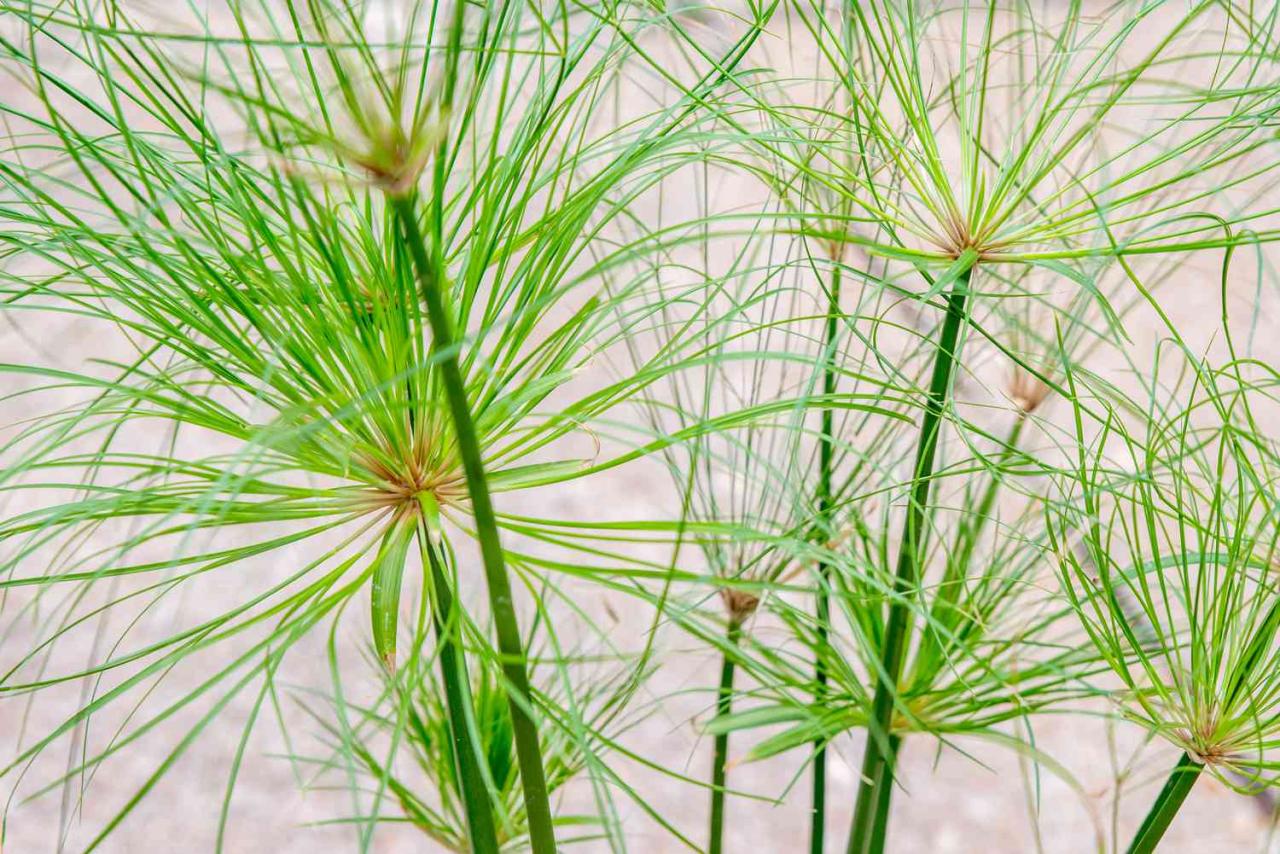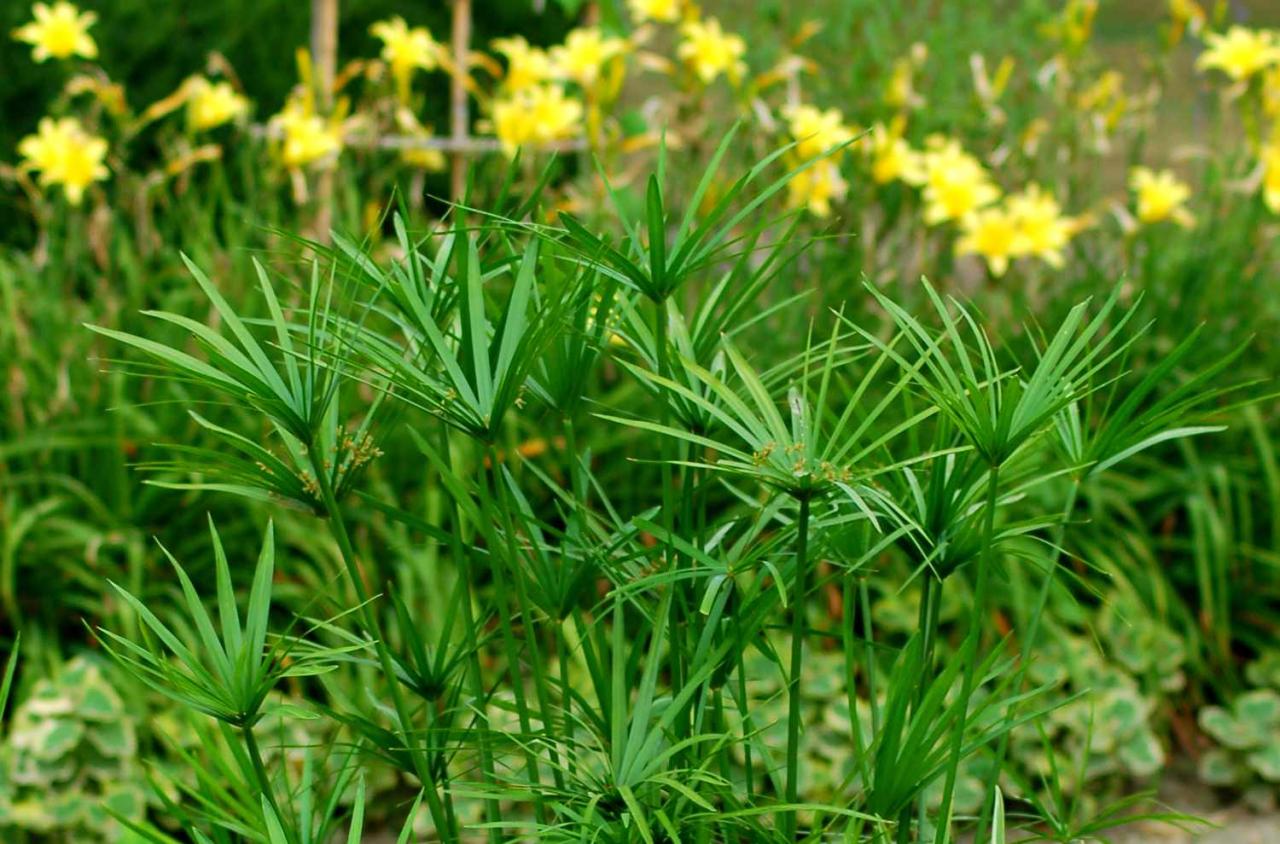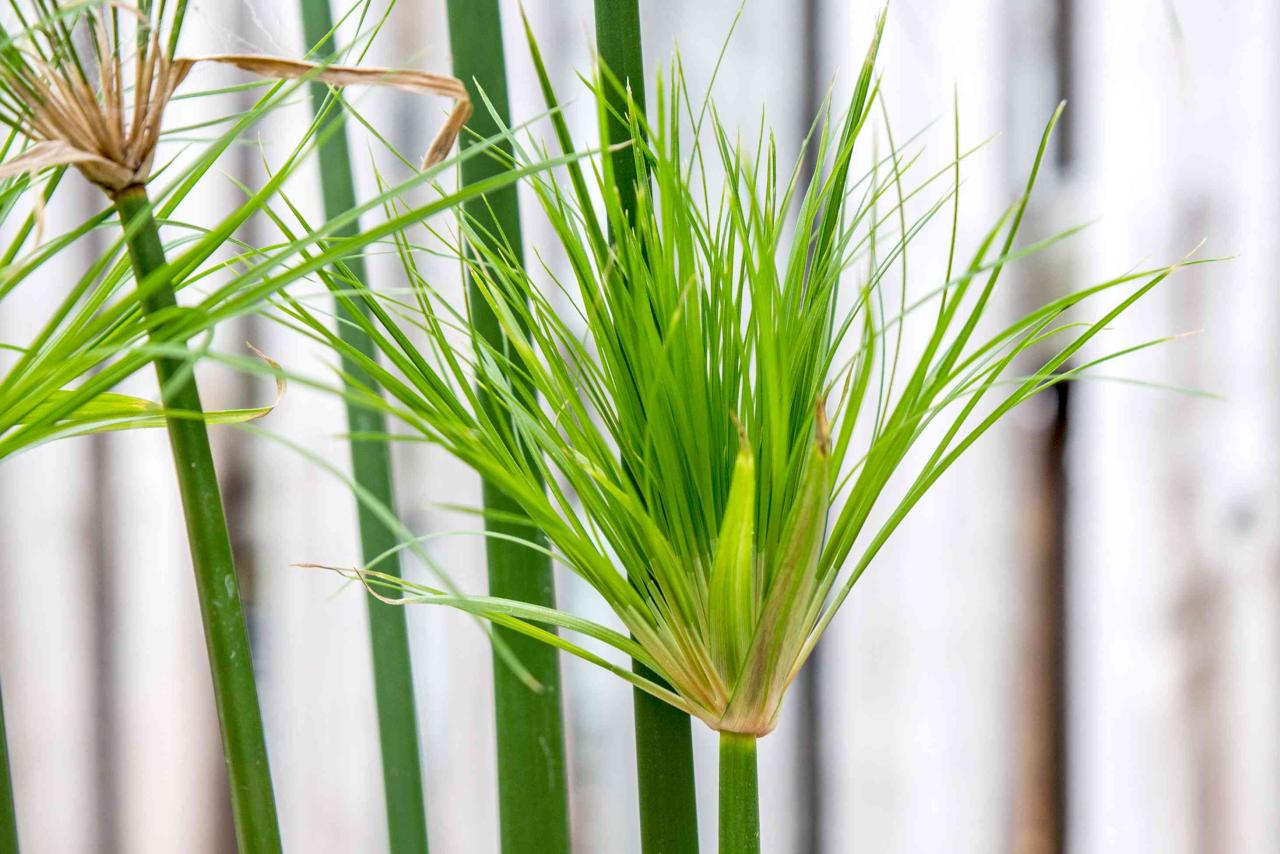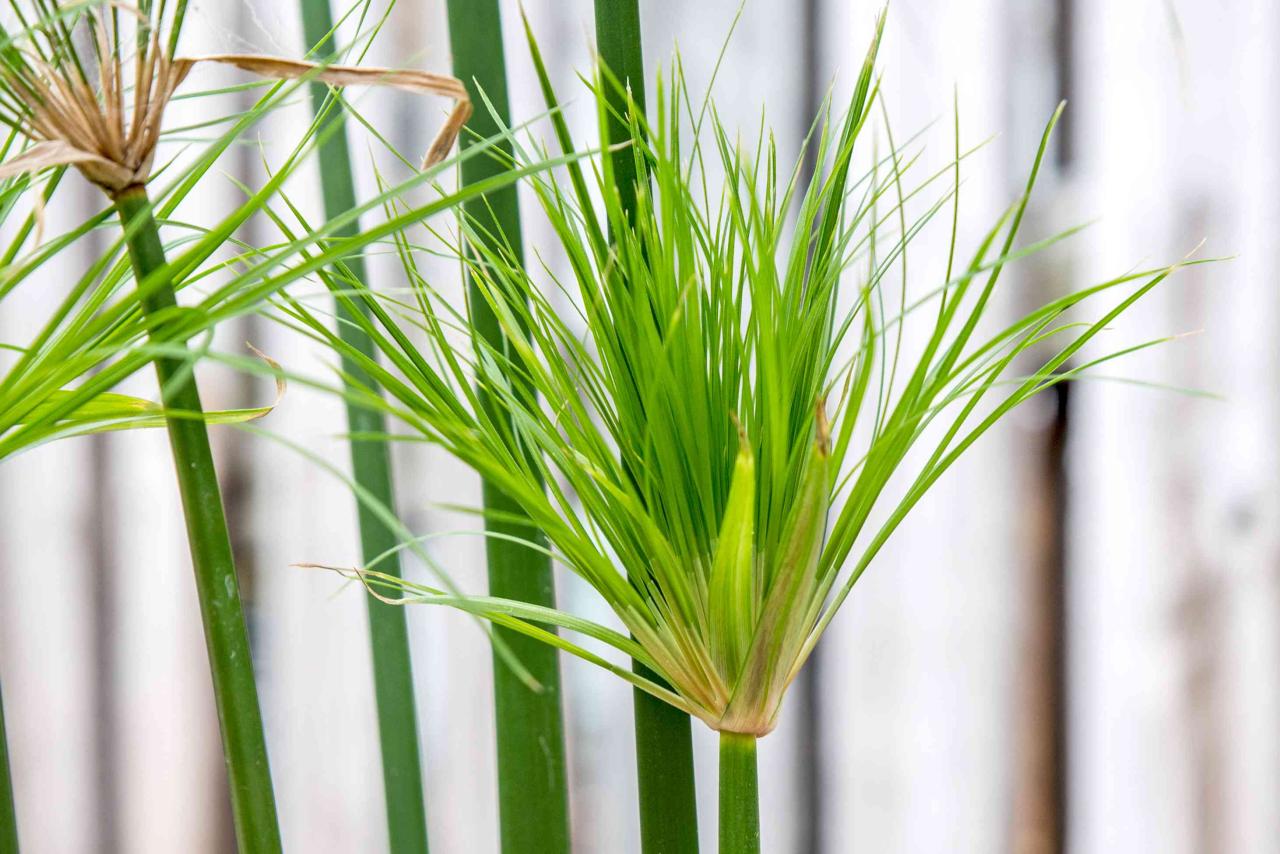Papyrus Plant Benefits: How to Grow and Utilize This Ancient Herb for a Stunning Garden – the very name evokes images of ancient Egypt, a time when this remarkable plant was the foundation of writing, art, and everyday life.
The papyrus plant, with its striking architectural form and lush foliage, has transcended its historical significance to become a prized addition to modern gardens. From its role in ancient Egyptian society to its versatility in contemporary landscaping, the papyrus plant offers a unique blend of beauty, history, and practicality.
This comprehensive guide delves into the fascinating world of the papyrus plant, exploring its origins, botanical characteristics, cultivation techniques, and diverse applications in garden design. We’ll uncover the secrets to successfully cultivating this ancient herb, transforming your garden into a haven of tropical elegance and historical charm.
The Papyrus Plant
The papyrus plant, scientifically known asCyperus papyrus*, has played a pivotal role in human history, particularly in ancient Egypt. Its versatility and abundance made it a cornerstone of Egyptian civilization, influencing their culture, economy, and everyday life.
The Papyrus Plant in Ancient Egypt
The papyrus plant was an integral part of ancient Egyptian society, serving numerous purposes beyond its aesthetic appeal. The plant’s tall, triangular stems, reaching heights of up to 15 feet, were harvested for their fibrous inner pith. This pith was then processed into thin sheets, forming the famous papyrus paper, a material that revolutionized communication and record-keeping in the ancient world.
The Papyrus plant, with its striking vertical growth and historical significance, can add a unique touch to any garden. Its feathery plumes provide a dramatic contrast against other foliage, and its versatility extends beyond aesthetics. You can use the plant’s strong stems for weaving baskets, crafting paper, or even creating decorative accents.
For those seeking to enhance their culinary adventures, consider exploring the aromatic world of citrus, particularly the fragrant Kaffir lime leaf, which can add a distinct and refreshing flavor to your dishes. How to Add Kaffir Lime Leaf to Your Meals: A Guide to Unique and Flavorful Dishes offers a comprehensive guide to incorporating this unique ingredient into your culinary repertoire.
Returning to the Papyrus plant, remember that its cultivation requires ample sunlight and moist soil, making it a rewarding addition to your outdoor space.
- The papyrus plant was a vital resource for writing and record-keeping. The Egyptians used papyrus to create scrolls, which were used for writing religious texts, legal documents, letters, and other forms of communication.
- The plant’s versatility extended beyond writing. Papyrus was also used for making mats, baskets, sandals, rope, and even boats.
- The papyrus plant’s cultural significance is evident in its presence in ancient Egyptian art and symbolism. The plant was often depicted in hieroglyphs, representing life, fertility, and the Nile River.
The Papyrus Plant’s Role in Writing and Papermaking
The papyrus plant’s most notable contribution to human civilization is its role in writing and papermaking. The process of making papyrus paper was intricate and labor-intensive.
- The inner pith of the papyrus stem was carefully extracted and sliced into thin strips.
- These strips were then laid side by side, overlapping slightly, to form a sheet.
- A second layer of strips was placed perpendicular to the first, creating a cross-hatched pattern.
- The layers were then pressed together, moistened, and left to dry in the sun.
- The resulting sheet was smooth and durable, providing a surface suitable for writing with ink.
Papyrus scrolls were the primary medium for writing in ancient Egypt. They were used to record historical events, religious beliefs, legal codes, and personal correspondence. The use of papyrus for writing and record-keeping played a crucial role in preserving ancient Egyptian knowledge and culture.
The Papyrus Plant’s Botanical Characteristics: Papyrus Plant Benefits: How To Grow And Utilize This Ancient Herb For A Stunning Garden

The papyrus plant, scientifically known asCyperus papyrus*, is a remarkable aquatic plant with a rich history. It has been used for centuries for various purposes, from paper production to building materials. Its distinctive appearance and unique adaptability make it a fascinating and valuable plant.
Physical Characteristics
The papyrus plant is a tall, graceful plant that can reach heights of up to 10 feet. Its stems are triangular in cross-section and are typically green to brown in color. The plant’s most striking feature is its large, umbrella-shaped cluster of leaves, which emerge from the top of the stem.
These leaves are long and slender, with a distinctive feathery appearance. They are typically green, but can also be tinged with reddish-brown hues.
Growth Habits and Preferred Growing Conditions
Papyrus plants are fast-growing and thrive in wet, marshy environments. They prefer full sun to partial shade and require consistently moist soil. The plant’s roots are adapted to grow in waterlogged conditions, making it an ideal choice for water gardens, ponds, and other aquatic settings.
They can tolerate a wide range of water temperatures, but prefer warmer conditions.
Adaptability to Wet Environments
The papyrus plant’s unique ability to thrive in wet environments is due to its specialized root system. Its roots are able to extract oxygen from the water, allowing the plant to survive in oxygen-deficient conditions. This adaptation makes the papyrus plant an important component of wetland ecosystems, providing habitat and food for a variety of wildlife.
Cultivating Papyrus Plants
Cultivating papyrus plants in your garden can be a rewarding experience, adding a touch of ancient charm and tropical elegance. These plants are relatively easy to grow and thrive in warm, humid environments, making them a perfect addition to water gardens, ponds, or even containers.
Selecting the Right Location
Choosing the right location is crucial for the successful cultivation of papyrus plants. They prefer full sun to partial shade, with at least six hours of direct sunlight daily. Ideally, the location should be sheltered from strong winds, which can damage the delicate stems and leaves.
Soil Requirements
Papyrus plants thrive in moist, well-draining soil. A mixture of loam, peat moss, and sand provides the ideal balance of drainage and moisture retention. It’s important to avoid planting them in heavy clay soil, which can lead to root rot.
Watering Techniques
Papyrus plants require consistent moisture and are best grown near a water source. The soil should be kept moist but not waterlogged. During hot weather, you may need to water them daily. It’s recommended to water them in the morning to allow the soil to dry slightly before nightfall.
Sunlight and Humidity
Papyrus plants are sun-loving plants that thrive in warm, humid environments. They require at least six hours of direct sunlight daily. In cooler climates, you can provide additional humidity by misting the plants regularly or placing them near a humidifier.
Propagation
Papyrus plants can be propagated through seeds or by dividing the plant. Seeds can be sown directly into the soil in spring or summer. Division is best done in the spring or early summer, separating the plant into smaller clumps with roots.
The Papyrus Plant’s Versatility in Garden Design

The papyrus plant, with its striking architectural form and tropical charm, can be a captivating addition to any garden design. Its versatility allows for creative use as a focal point, accent, or even a natural screen, adding a touch of elegance and a sense of the exotic.
Incorporating Papyrus Plants as Focal Points
The papyrus plant’s towering stature and unique silhouette make it an excellent choice for creating a focal point in a garden. Its dramatic presence can draw the eye and create a sense of depth and interest. Consider planting a large papyrus plant in a prominent location, such as the center of a circular bed or at the end of a walkway.
Its towering height and feathery foliage will command attention and create a striking visual contrast against other plants.
Utilizing Papyrus Plants as Accents
While papyrus plants can be stunning focal points, they can also be used as accents to enhance the beauty of other plants. Their upright growth habit and airy texture create a delicate contrast against more rounded or trailing plants. Planting papyrus plants in groups along the edges of a garden bed or in containers near seating areas can add a touch of whimsy and visual interest.
Integrating Papyrus Plants into Water Features
Papyrus plants are naturally associated with water, and their presence near ponds or water features can enhance the overall aesthetic. Their feathery foliage gracefully sways in the breeze, creating a gentle movement that complements the tranquility of water. Planting papyrus plants around the edges of a pond or in shallow water creates a natural and visually appealing transition between the water and the surrounding landscape.
Designing Container Gardens with Papyrus Plants
Papyrus plants are well-suited for container gardens, adding a touch of tropical flair to balconies, patios, or even indoor spaces. They can be planted in large pots or planters, either individually or in combination with other water-loving plants, such as water lilies or lotus.
Their unique foliage provides a textural contrast and creates a sense of verticality, adding depth and interest to the container garden.
Table: Papyrus Plant Applications in Garden Design
Application |
Description |
Example |
|---|---|---|
Focal Point |
Plant a large papyrus plant in the center of a circular bed to create a striking visual centerpiece. |
A large papyrus plant planted in a prominent location, such as the center of a circular bed, surrounded by smaller plants like ferns or hostas. |
Accent |
Plant papyrus plants in groups along the edges of a garden bed or in containers near seating areas to add visual interest. |
A group of papyrus plants planted along the edge of a flower bed, creating a natural screen and adding height and texture. |
Water Feature |
Plant papyrus plants around the edges of a pond or in shallow water to create a natural transition between the water and the surrounding landscape. |
Papyrus plants planted around the edges of a small pond, their feathery foliage swaying in the breeze, creating a serene and natural atmosphere. |
Container Garden |
Plant papyrus plants in large pots or planters, either individually or in combination with other water-loving plants. |
A large pot containing a papyrus plant, water lilies, and lotus, creating a vibrant and tropical-themed container garden. |
Benefits of Growing Papyrus Plants
Papyrus plants offer a wide range of benefits, contributing to a thriving ecosystem, enhancing the aesthetics of your garden, and even promoting a sense of tranquility. Their unique characteristics make them a valuable addition to any garden, whether you are an experienced gardener or just starting out.
Environmental Benefits of Papyrus Plants
Papyrus plants play a significant role in promoting biodiversity and maintaining a healthy ecosystem. They provide shelter and food for various wildlife, contributing to a thriving natural environment.
- Habitat for Wildlife:The dense foliage of papyrus plants provides a safe haven for birds, reptiles, and amphibians, offering protection from predators and harsh weather conditions. These plants also serve as a nesting site for many bird species, contributing to the overall biodiversity of the area.
- Water Purification:Papyrus plants are known for their exceptional water purification abilities. Their roots filter out pollutants and excess nutrients from water bodies, improving water quality and creating a healthier environment for aquatic life. This natural filtration process helps to maintain the balance of the ecosystem and protect aquatic species.
- Soil Improvement:The extensive root system of papyrus plants helps to improve soil quality by preventing erosion and increasing soil aeration. Their decaying leaves and stems enrich the soil with organic matter, enhancing its fertility and promoting plant growth. This natural process contributes to a healthier and more productive garden ecosystem.
Aesthetic Appeal of Papyrus Plants
Papyrus plants are renowned for their striking appearance, adding a touch of tropical elegance to any garden. Their tall, graceful stems and feathery foliage create a sense of grandeur and sophistication, transforming ordinary spaces into breathtaking oases.
Papyrus plants, with their striking architectural form, add a touch of ancient elegance to any garden. These water-loving plants thrive in moist conditions, similar to the ideal environment for establishing a lush lawn. To ensure a thriving lawn, understanding the best time to sow grass seed is crucial, as outlined in this informative guide: When to Sow Grass Seed: Expert Advice for a Beautiful and Green Lawn.
By combining the graceful presence of papyrus plants with a beautifully maintained lawn, you can create a garden that seamlessly blends ancient charm with modern appeal.
- Tropical Ambiance:Papyrus plants evoke a sense of tropical paradise, bringing a touch of exotic beauty to any garden. Their lush foliage and tall stems create a vibrant and inviting atmosphere, transporting you to a tranquil island getaway.
- Architectural Interest:The unique architecture of papyrus plants adds a distinct visual element to any garden design. Their tall, slender stems and feathery foliage create a sense of verticality and movement, adding depth and dimension to the landscape.
- Versatile Design Options:Papyrus plants are incredibly versatile and can be incorporated into a variety of garden styles. They can be used as focal points, creating dramatic accents in the landscape. Alternatively, they can be planted in groups to create a sense of privacy or to soften the edges of a garden space.
The Papyrus Plant’s Traditional Uses
The papyrus plant, a symbol of ancient Egypt, played a vital role in the lives of the people who lived along the Nile River. Its versatility and abundance made it a crucial resource for various purposes, from crafting essential tools to creating works of art.
The plant’s uses extended beyond its symbolic significance. The ancient Egyptians, along with other civilizations, ingeniously utilized the papyrus plant’s unique characteristics for a wide range of applications. This section will delve into the fascinating world of papyrus plant uses in ancient Egypt and beyond.
Papyrus Plant Uses in Ancient Egypt, Papyrus Plant Benefits: How to Grow and Utilize This Ancient Herb for a Stunning Garden
The ancient Egyptians were renowned for their mastery in utilizing the papyrus plant. This section explores some of the significant uses of papyrus in ancient Egypt.
- Paper Production:The most famous use of papyrus was in papermaking. The plant’s stem was carefully peeled and sliced into thin strips. These strips were then layered and pressed together, creating a durable sheet that served as a writing surface.
Papyrus scrolls were used for writing, recording historical events, and preserving knowledge.
- Crafting:Beyond its use in papermaking, the papyrus plant was also utilized to create various everyday items. Its fibers were woven into mats, baskets, sandals, and even rope. The strength and flexibility of the papyrus plant made it an ideal material for these crafts.
- Building Materials:The Egyptians used papyrus for construction as well. Its stems were woven together to create lightweight and durable mats that were used as roofing material for houses and shelters.
- Medicinal Properties:The papyrus plant also held medicinal significance in ancient Egypt. Its roots were used to treat ailments like fever and diarrhea, while its sap was believed to have healing properties for wounds and skin infections.
Papyrus Plant Uses in Other Cultures
The papyrus plant’s versatility extended beyond the borders of ancient Egypt. Its uses were adopted by other civilizations, showcasing its widespread importance.
- Ancient Greeks and Romans:The Greeks and Romans also utilized papyrus for writing, crafting, and medicinal purposes. Papyrus scrolls were essential for preserving their literature and historical records.
- Other African Cultures:The papyrus plant was also utilized by various African cultures. In some regions, it was used for fishing nets, while in others, it served as a source of fuel.
Last Word

By incorporating the papyrus plant into your garden, you’re not simply adding a visually striking element; you’re embracing a piece of history, fostering biodiversity, and enhancing the natural beauty of your surroundings. Whether you’re seeking to create a serene water feature, a dramatic focal point, or simply add a touch of tropical flair, the papyrus plant offers a wealth of possibilities, inviting you to explore the rich legacy of this ancient wonder.
FAQ Overview
Is the papyrus plant invasive?
While papyrus plants can spread quickly in ideal conditions, they are generally not considered invasive in most areas. However, it’s essential to monitor their growth and prune them regularly to maintain their desired size and prevent them from becoming overwhelming.
Can I grow papyrus plants indoors?
Yes, papyrus plants can be grown indoors, but they require bright, indirect light and consistent humidity. A sunny windowsill or a well-lit room with a humidifier can create a suitable environment for indoor cultivation.
Are papyrus plants toxic to pets?
Papyrus plants are generally considered non-toxic to pets, but it’s always best to err on the side of caution. Keep an eye on your pets around the plants and consult with a veterinarian if you have any concerns.
